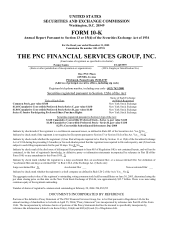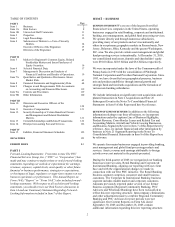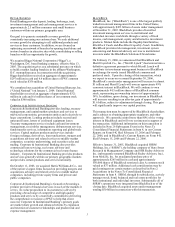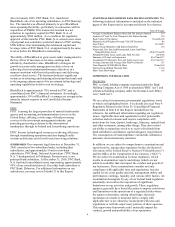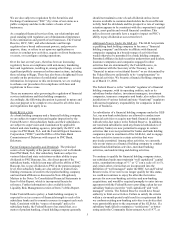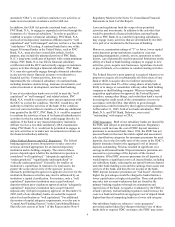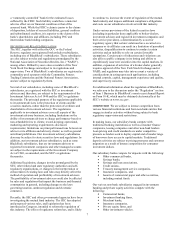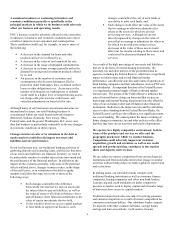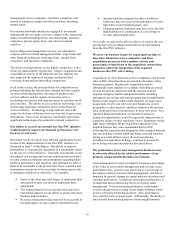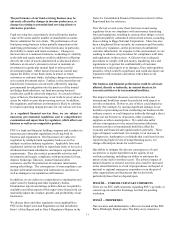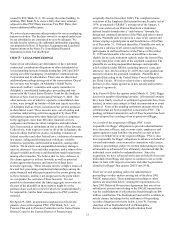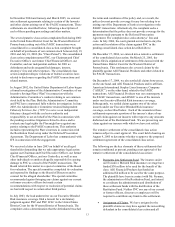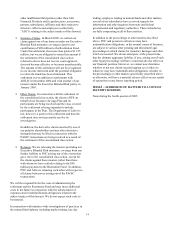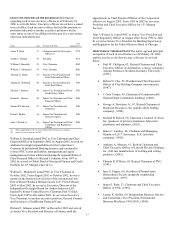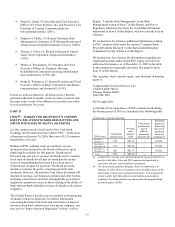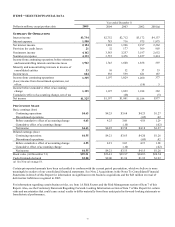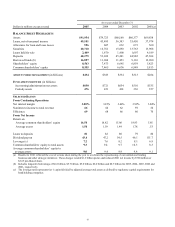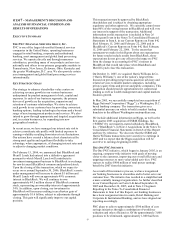PNC Bank 2005 Annual Report Download - page 9
Download and view the complete annual report
Please find page 9 of the 2005 PNC Bank annual report below. You can navigate through the pages in the report by either clicking on the pages listed below, or by using the keyword search tool below to find specific information within the annual report.9
A sustained weakness or weakening in business and
economic conditions generally or specifically in the
principal markets in which we do business could adversely
affect our business and operating results.
PNC’ s business could be adversely affected to the extent that
weaknesses in business and economic conditions have direct
or indirect impacts on our customers and counterparties.
These conditions could lead, for example, to one or more of
the following:
• A decrease in the demand for loans and other
products and services offered by us,
• A decrease in the value of our loans held for sale,
• A decrease in the usage of unfunded commitments,
• A decrease in customer savings generally and in the
demand for savings and investment products offered
by us, and
• An increase in the number of customers and
counterparties who become delinquent, file for
protection under bankruptcy laws, or default on their
loans or other obligations to us. An increase in the
number of delinquencies, bankruptcies or defaults
could result in a higher level of nonperforming assets,
net charge-offs, provision for credit losses, and
valuation adjustments on loans held for sale.
Although many of our businesses are national and some are
international in scope, our retail banking business is
concentrated within our retail branch network footprint
(Delaware, Indiana, Kentucky, New Jersey, Ohio,
Pennsylvania, and the greater Washington, D.C. area), and
thus that business is particularly vulnerable to adverse changes
in economic conditions in these regions.
Changes in interest rates or in valuations in the debt or
equity markets could directly impact our assets and
liabilities and our performance.
Given our business mix, our traditional banking activities of
gathering deposits and extending loans, and the fact that most
of our assets and liabilities are financial in nature, we tend to
be particularly sensitive to market interest rate movement and
the performance of the financial markets. In addition to the
impact on the economy generally, with some of the potential
effects outlined above, changes in interest rates, in the shape
of the yield curve, or in valuations in the debt or equity
markets could directly impact us in one or more of the
following ways:
• Such changes could affect the difference
between the interest that we earn on assets and
the interest that we pay on liabilities, as well as
the value of some or all of our on-balance sheet
and off-balance sheet financial instruments or the
value of equity investments that we hold,
• To the extent to which we access capital markets
to raise funds to support our business, such
changes could affect the cost of such funds or
our ability to raise such funds, and
• Such changes could affect the value of the assets
that we manage or otherwise administer for
others or the assets for which we provide
processing services. Although we are not
directly impacted by changes in the value of
assets that we manage or administer for others or
for which we provide processing services,
decreases in the value of those assets would
affect our fee income relating to those assets and
could result in decreased demand for our
services.
As a result of the high percentage of our assets and liabilities
that are in the form of interest-bearing instruments, the
monetary, tax and other policies of the government and its
agencies, including the Federal Reserve, which have a significant
impact on interest rates and overall financial market
performance, can affect the activities and results of operations of
bank holding companies and their subsidiaries, such as PNC and
our subsidiaries. An important function of the Federal Reserve
is to regulate the national supply of bank credit and market
interest rates. The actions of the Federal Reserve influence the
rates of interest that we charge on loans and that we pay on
borrowings and interest-bearing deposits and can also affect the
value of our on-balance sheet and off-balance sheet financial
instruments. Both due to the impact on rates and by controlling
access to direct funding from the Federal Reserve Banks, the
Federal Reserve’ s policies also influence, to a significant extent,
our cost of funding. We cannot predict the nature or timing of
future changes in monetary, tax and other policies or the effect
that they may have on our activities and results of operations.
We operate in a highly competitive environment, both in
terms of the products and services we offer and the
geographic markets in which we conduct business.
Competition could adversely impact our customer
acquisition, growth and retention, as well as our credit
spreads and product pricing, causing us to lose market
share and deposits and revenues.
We are subject to intense competition from various financial
institutions and from non-bank entities that engage in similar
activities without being subject to bank regulatory supervision
and restrictions.
In making loans, our subsidiary banks compete with
traditional banking institutions as well as consumer finance
companies, leasing companies and other non-bank lenders.
Loan pricing and credit standards are under competitive
pressure as lenders seek to deploy capital and a broader range
of borrowers have access to capital markets.
Traditional deposit activities are subject to pricing pressures
and customer migration as a result of intense competition for
consumer investment dollars. Our subsidiary banks compete
for deposits with other commercial banks, savings banks,
savings and loan associations, credit unions, treasury

